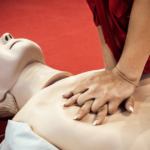Meditation for Beginners: Types and Health Benefits

Meditation has become increasingly popular among beginners in recent years, as people look for ways to find inner peace, reduce stress, and improve their overall well-being. But what exactly is meditation?
At its core, meditation is a practice that involves training the mind to focus and redirect thoughts. It is a way to achieve a state of mental clarity and emotional calmness. While meditation has been practiced for centuries in various cultures, its benefits are now being recognized by a wider audience.
The Importance of Choosing the Right Type of Meditation
Choosing the right type of meditation practice is crucial for beginners to maximize the benefits they can experience. With different types of meditation available, each offering unique approaches and techniques, it’s important to find one that resonates with you.
In this article, we will explore the different types of meditation suitable for beginners and discuss their health benefits. By understanding the options available, you can embark on your meditation journey with confidence and discover the transformative power of this ancient practice.
Understanding Meditation: A Beginner’s Guide
Getting started with meditation can be an enriching journey towards inner peace and self-discovery. As a beginner, it’s essential to lay a strong foundation for your practice by understanding practical tips for creating a conducive environment and embracing simple yet effective meditation techniques.
Starting Your Meditation Journey: Practical Tips for Beginners
Creating a peaceful environment that supports your practice is crucial for establishing a consistent and fulfilling meditation routine. Here are some practical tips to help beginners embark on their meditation journey:
1. Declutter Your Space
Clearing your meditation area of any clutter can help minimize distractions and create a serene atmosphere for your practice. Whether it’s a dedicated room or a small corner in your home, maintaining tidiness can contribute to a sense of calm and focus.
2. Personalize Your Sanctuary
Adding personal touches to your meditation space can make it more inviting and reflective of your unique preferences. Consider incorporating elements such as soothing colors, inspiring artwork, or meaningful objects that resonate with you.
3. Choose Comfortable Seating
Selecting a comfortable cushion, chair, or mat to sit on during meditation can enhance your overall experience. Opt for seating that supports good posture while also allowing you to relax effortlessly.
4. Set the Mood with Lighting
Soft, gentle lighting can create an ambiance of tranquility and relaxation. Experiment with dimmed or natural light sources to find what best suits your preference for a calming environment.
5. Minimize Distractions
Silence your electronic devices and minimize external noises to foster a sense of serenity during your practice. Creating an oasis of quietude can amplify the benefits of meditation.
By implementing these practical tips, you can establish an inviting and tranquil space that nurtures your meditation journey.
Remember, the essence of meditation lies not only in the technique itself but also in the environment you cultivate around it. Embracing simplicity and mindfulness in setting up your meditation space can greatly enhance the quality of your practice as a beginner.

Breath Awareness Meditation: A Step-by-Step Guide for Beginners
Breath awareness meditation is a foundational practice that can help beginners develop focus, mindfulness, and a deeper connection with their breath. This technique involves paying attention to the natural inhalation and exhalation of the breath, using it as an anchor to cultivate present-moment awareness.
Getting Started with Meditation
To begin your breath awareness meditation practice:
- Setting Up Your Meditation Space: Find a quiet and comfortable space where you can sit or lie down without distractions. Consider using cushions or a meditation mat for added comfort.
- Posture: Sit with a straight back, relaxed shoulders, and hands resting comfortably. If sitting on the floor is uncomfortable, you can also practice breath awareness meditation while lying down.
- Duration: Start with short sessions, such as 5-10 minutes, and gradually increase the duration as you become more comfortable with the practice.
Explaining the Science-Backed Benefits of Meditation
Research has shown that regular practice of breath awareness meditation can have profound effects on mental and physical well-being:
- Stress Reduction: By focusing on the breath, individuals can experience a sense of calm and relaxation, reducing stress levels over time.
- Improved Concentration: Breath awareness meditation trains the mind to stay present, which can enhance concentration and mental clarity.
- Emotional Regulation: Practicing this technique can help individuals observe their thoughts and emotions without being overwhelmed by them.
- Enhanced Self-Awareness: By becoming attuned to the breath, practitioners can develop a deeper understanding of their inner state and emotional patterns.
Common Challenges for Beginners
As you embark on your breath awareness meditation journey, you may encounter common challenges such as:
- Restlessness: It’s normal to feel restless or distracted during the initial stages of practice. Gently guide your focus back to the breath whenever your mind wanders.
- Intrusive Thoughts: Thoughts may arise during meditation; acknowledge them without judgment and gently return your attention to the breath.
By acknowledging these challenges as part of the learning process, beginners can approach their practice with patience and self-compassion. With consistent effort, breath awareness meditation can become an invaluable tool for inner peace and self-discovery.
Exploring Different Types of Meditation for Beginners
When it comes to meditation, there are various techniques and styles to choose from. Each type of meditation offers unique benefits and approaches to cultivating mindfulness and inner peace. Here are some popular types of meditation suitable for beginners:
1. Mindfulness Meditation
Mindfulness meditation is one of the most widely practiced forms of meditation. It involves paying attention to the present moment without judgment. This practice helps individuals develop a non-reactive awareness of their thoughts, emotions, and sensations. Mindfulness meditation can be done in various ways, such as focusing on the breath, body sensations, or everyday activities like eating or walking.
2. Loving-Kindness Meditation
Loving-kindness meditation is a practice that cultivates feelings of compassion and love towards oneself and others. It involves repeating specific phrases or intentions to generate feelings of kindness and goodwill. This type of meditation can help beginners develop self-compassion, improve relationships, and reduce stress.
3. Transcendental Meditation
Transcendental Meditation (TM) is a technique that involves silently repeating a mantra—a word or sound—during meditation. This practice aims to bring about a state of deep relaxation and transcendence. TM is known for its simplicity and accessibility, making it suitable for beginners who prefer a structured approach.
4. Guided Visualization
Guided visualization is a form of meditation that uses mental imagery to evoke relaxation and positive experiences. It typically involves listening to a recorded audio guide that directs your imagination towards specific scenes or scenarios. This type of meditation can be helpful for beginners who find it challenging to focus solely on their breath or bodily sensations.
5. Body Scan Meditation
Body scan meditation involves systematically focusing attention on different parts of the body, from head to toe, while cultivating awareness and relaxation. This practice helps beginners develop body awareness, release tension, and promote overall well-being.
6. Mantra Meditation
Mantra meditation involves the repetition of a specific word, phrase, or sound to quiet the mind and induce a state of calmness. This type of meditation can be done silently or aloud. Mantra meditation is suitable for beginners who prefer a more structured practice and find comfort in the rhythmic repetition of sounds.
It’s important to remember that there is no right or wrong type of meditation. It’s all about finding what resonates with you and your personal preferences. You may want to explore different techniques and experiment with various styles to discover what works best for you.
By exploring different types of meditation, beginners can gain a deeper understanding of their own minds and develop valuable tools for managing stress, enhancing focus, and cultivating inner peace.
Keep reading to learn about overcoming common obstacles in meditation and incorporating mindfulness into everyday life.
The Transformative Power of Consistency: Establishing a Meditation Routine
Consistency is key when it comes to reaping the benefits of meditation. Just like any other practice, regularity in your meditation routine helps you deepen your experience and integrate it into your daily life. In this section, we will explore the importance of consistency in meditation practice and address common challenges that beginners may encounter.
Overcoming Common Obstacles in Meditation: Practical Tips for Beginners
As a beginner, you may face various challenges during your meditation practice. These challenges can sometimes discourage you or make you feel like giving up. However, with the right mindset and actionable strategies, you can overcome these obstacles and continue to progress on your meditation journey. Here are some common hurdles beginners may encounter and practical tips to help you navigate through them:
1. Restlessness
It’s common for the mind to wander during meditation, especially in the beginning. Restlessness can manifest as fidgeting, a racing mind, or an inability to sit still. To overcome restlessness:
- Start with shorter meditation sessions and gradually increase the duration as you build your focus.
- Experiment with different meditation techniques to find one that resonates with you.
- Use guided meditations or mindfulness apps to provide structure and support.
2. Intrusive thoughts
It’s natural for thoughts to arise during meditation. However, when these thoughts become intrusive and distract you from your practice, it can be challenging to stay focused. To deal with intrusive thoughts:
- Acknowledge the thoughts without judgment and let them pass by shifting your attention back to your breath or chosen focal point.
- Practice self-compassion by gently redirecting your attention whenever you notice yourself getting caught up in thoughts.
- Consider journaling before or after your meditation session as a way to release any lingering thoughts or concerns.
3. Lack of motivation
It’s not uncommon to feel less motivated or find excuses to skip your meditation practice, especially when you’re just starting out. To stay motivated:
- Set realistic goals and start with shorter sessions. Consistency is more important than the length of each session.
- Create a dedicated meditation space that inspires you and makes it easier to get into the right mindset.
- Find an accountability partner or join a meditation group to help you stay committed and motivated.
4. Physical discomfort
Sitting for an extended period can sometimes lead to physical discomfort, such as back pain or stiffness. To alleviate physical discomfort:
- Experiment with different sitting positions, such as cross-legged on a cushion, kneeling, or using a meditation bench or chair.
- Use props like cushions or blankets to support your posture and make yourself comfortable.
- Consider incorporating gentle stretching or yoga exercises before your meditation practice to release tension in your body.
Remember, meditation is a practice, and progress takes time. Be patient with yourself and embrace the challenges as opportunities for growth. With consistent effort and a willingness to adapt, you will gradually overcome these obstacles and experience the transformative power of meditation.
“The obstacles in our practice are the path itself.” – Chögyam Trungpa
Extending the Benefits of Mindfulness to Everyday Life
Consistency is key when it comes to experiencing the long-term benefits of meditation. If you’re new to meditation, you might be wondering how to make mindfulness a part of your daily routine. The good news is that you can practice mindfulness in various activities throughout the day, not just during formal meditation sessions.
How to Practice Mindfulness in Daily Life
Here are some simple ways beginners can incorporate mindfulness into their everyday activities:
- Be Present While Eating: Instead of rushing through meals, take the time to fully engage with your food. Notice the smells, flavors, and textures as you eat. Chew slowly and savor each bite. This not only enhances your enjoyment of the meal but also helps you tune in to your body’s hunger and fullness signals.
- Take Mindful Walks: Going for a walk can be an opportunity to connect with the present moment. As you walk, pay attention to the sensations in your feet and legs, the movement of your body, and the sights and sounds around you. If your mind starts to wander, gently bring it back to the present moment by focusing on your breath or the feeling of your feet touching the ground.
- Practice Active Listening: In our fast-paced world, it’s easy to be distracted during conversations. To cultivate mindfulness in communication, make a conscious effort to truly listen when someone is speaking to you. Put aside any distractions and give them your full attention. Notice any thoughts or judgments that arise in your mind as you listen, but try not to get caught up in them. Instead, bring your focus back to what the person is saying.

Bringing Mindfulness into Daily Life
By regularly practicing mindfulness in these simple ways, beginners can start to experience its benefits outside of formal meditation sessions:
- Improved focus and concentration
- Reduced stress and anxiety
- Enhanced self-awareness
- Better emotional regulation
Remember, mindfulness is not about achieving a particular state of mind; it’s about being aware of the present moment without judgment. So, whether you’re eating, walking, or talking to someone, try to bring a sense of curiosity and openness to whatever you’re doing. Over time, this can become a natural part of how you approach life, leading to greater overall well-being and personal growth.
Choosing Your Path: Selecting the Right Meditation Style for You
Finding the right meditation style is an essential step for beginners to establish a sustainable and fulfilling practice. With numerous techniques and approaches available, it’s important to explore different meditation styles and trust your intuition in finding a practice that resonates with you. Here are some tips to help you make an informed decision:
1. Research and Educate Yourself
Take the time to learn about various meditation styles and their principles. Understanding the differences between mindfulness, loving-kindness, transcendental meditation, and other techniques will give you a clearer idea of what each practice entails.
2. Consider Your Goals and Preferences
Reflect on your reasons for wanting to meditate. Are you seeking stress relief, emotional balance, or spiritual growth? Different meditation styles align with different goals. Additionally, consider your personal preferences such as the level of guidance you prefer (guided vs. self-guided) or whether you enjoy incorporating movement into your practice.
3. Try Different Styles
Experiment with different meditation styles to see which ones resonate with you.
- Attend classes or workshops
- Try online resources
- Explore meditation apps that offer a variety of guided sessions
By experiencing different techniques firsthand, you can better understand which practices feel most natural and beneficial to you.
4. Listen to Your Intuition
Ultimately, trust your instincts in choosing a meditation style. Pay attention to how each technique makes you feel during and after the practice. Notice if there is a sense of ease, connection, or resonance with a particular method.
Your intuition will guide you towards the style that aligns best with your needs and values.
Remember that there is no one-size-fits-all approach to meditation. What works for others may not work for you, and vice versa.
Embrace the journey of exploration and be open to trying new styles as your practice evolves. The most important thing is to find a meditation style that allows you to connect with yourself, cultivate inner peace, and experience the transformative benefits of this ancient practice.
Meditation as a Tool for Well-Being: Understanding Its Impact on Stress and Anxiety
Meditation has gained significant recognition as an effective tool for managing stress and anxiety. With its calming and grounding effects, it can help individuals find inner peace and restore balance in their lives. In this section, we will explore the practice of body scan meditation, a powerful technique for easing anxiety and promoting relaxation.
Body Scan Meditation: A Grounding Practice for Easing Anxiety and Promoting Relaxation
Body scan meditation is a practice that involves systematically bringing attention to different parts of the body, from head to toe, in order to cultivate body awareness and release tension. It is particularly beneficial for those experiencing anxiety as it helps redirect focus away from racing thoughts and into the present moment. Here is a step-by-step guide for beginners:
- Find a comfortable position: Start by finding a quiet place where you can sit or lie down comfortably. Close your eyes and take a few deep breaths to relax your body.
- Bring awareness to your breath: Begin by focusing your attention on your breath. Notice the sensation of the breath entering and leaving your body. Allow yourself to fully experience each inhale and exhale.
- Scan through your body: Slowly shift your attention to different parts of your body, starting from the top of your head and gradually moving down to your toes. As you focus on each area, observe any sensations or feelings that arise without judgment.
- Release tension: When you come across areas of tension or discomfort, consciously relax those muscles by taking a deep breath in and gently exhaling while letting go of any tension you may be holding.
- Cultivate body awareness: As you continue scanning through each part of your body, bring curiosity and openness to the experience. Notice how each part feels – its temperature, texture, and any subtle sensations that arise.
- Practice self-compassion: Throughout the body scan, remind yourself to be gentle and kind to yourself. If your mind wanders, gently bring it back to the present moment and continue with the practice. Remember, there is no right or wrong way to do this meditation.
By regularly practicing body scan meditation, you can develop a deeper connection with your body and cultivate a sense of relaxation and calmness. This technique allows you to become more attuned to the physical sensations within your body, helping you identify areas of tension or discomfort that may be contributing to your anxiety. By releasing this tension, you create space for healing and restoration.
The Benefits of Body Scan Meditation for Stress and Anxiety
Research has shown that body scan meditation can have numerous benefits for overall well-being. It has been found to:
- Reduce stress levels
- Lower blood pressure
- Improve sleep quality
Additionally, this practice can enhance body awareness and promote a greater sense of self-care and self-compassion.
Incorporating Body Scan Meditation into Your Daily Routine
Incorporating body scan meditation into your daily routine can be a valuable tool for managing anxiety and creating a greater sense of peace in your life. It is important to remember that consistency is key when it comes to reaping the benefits of meditation. Even just a few minutes of practice each day can make a significant difference in managing stress and promoting overall well-being.
So, take some time for yourself today and try incorporating body scan meditation into your daily routine. Embrace the present moment, release tension from your body, and experience the transformative power of this grounding practice.
Loving-Kindness Meditation for Self-Compassion and Stress Reduction
Introducing the practice of loving-kindness meditation as a powerful tool for cultivating compassion towards oneself and others, with research-backed benefits.
What is Loving-Kindness Meditation?
Loving-kindness meditation, also known as metta meditation, is a practice that involves directing well-wishes and positive intentions towards oneself and others. It is a simple yet profound technique that can have transformative effects on our mental well-being.
How Does Loving-Kindness Meditation Work?
Loving-kindness meditation helps us develop a sense of warmth, kindness, and compassion towards ourselves and others. By intentionally directing loving thoughts and wishes towards ourselves and others, we cultivate a sense of connection and empathy.
Research-Backed Benefits of Loving-Kindness Meditation
Numerous studies have shown the positive impact of loving-kindness meditation on reducing stress, anxiety, and depression. It has been found to:
- Increase positive emotions
- Improve self-esteem
- Enhance social connections
- Decrease negative emotions
How to Practice Loving-Kindness Meditation
To practice loving-kindness meditation, follow these steps:
- Find a quiet and comfortable space where you won’t be disturbed.
- Close your eyes and take a few deep breaths to relax your body and mind.
- Repeat a series of phrases silently in your mind or softly out loud. Some common phrases used in loving-kindness meditation include:
- May I be happy.
- May I be healthy.
- May I live with ease.
- May all beings be happy.
- May all beings be healthy.
- May all beings live with ease.
- Start by directing these phrases towards yourself, genuinely wishing yourself well-being and happiness.
- Then, gradually extend these wishes to others, starting with loved ones, friends, neutral people, and eventually even to difficult individuals or all beings.
- Set aside a few minutes each day to engage in this practice, gradually increasing the duration as you feel comfortable.

Embracing the Practice of Loving-Kindness Meditation
By incorporating loving-kindness meditation into your daily routine, you can:
- Foster self-compassion
- Reduce stress and anxiety levels
- Cultivate a greater sense of well-being
This practice not only benefits ourselves but also creates a ripple effect of kindness and compassion in our relationships and communities.
Remember, there is no right or wrong way to practice loving-kindness meditation. It is a personal journey of cultivating love and compassion towards oneself and others. Embrace the practice with an open heart and allow it to unfold naturally.
Taking Your Practice Further: Resources and Support for Beginner Meditators
Meditation Apps for Beginners: Enhancing Your Practice with Technology
In today’s digital age, meditation apps have become valuable tools for beginners to establish and maintain a consistent practice. These apps offer a wide range of features designed to support and guide individuals as they embark on their meditation journey. Here are some top meditation apps that cater to beginners, along with their pros and cons:
1. Calm:
- Pros: Calm provides a variety of guided meditation sessions tailored for beginners, including breathing exercises and sleep stories. The app also offers soothing nature sounds and music to enhance relaxation.
- Cons: While Calm offers a free version with limited resources, access to the full library of content requires a subscription.
2. Headspace:
- Pros: Headspace is known for its user-friendly interface and structured meditation courses suitable for beginners. The app covers fundamental techniques such as breath awareness and body scan meditations.
- Cons: Similar to Calm, Headspace offers a subscription-based model for accessing all features.
3. Insight Timer:
- Pros: Insight Timer stands out for its extensive collection of free guided meditations from teachers around the world. It also includes a timer for self-guided practice and a supportive community feature.
- Cons: Navigating through the vast library of meditations can be overwhelming for beginners.
4. Mindfulness Daily:
- Pros: Mindfulness Daily offers short, daily mindfulness practices tailored for beginners, making it easy to integrate meditation into daily routines. The app also includes progress tracking and reminders.
- Cons: Some users may find the content repetitive over time.
5. 10% Happier:
- Pros: 10% Happier provides practical, no-nonsense guidance on meditation through its video lessons and guided sessions. The app focuses on debunking common myths about meditation.
- Cons: Access to the full range of features requires a subscription.
When exploring these apps, it’s essential for beginners to consider their personal preferences, such as the type of guidance they resonate with, the availability of free content, and the overall user experience. Experimenting with different apps can help individuals find the one that best suits their needs and aligns with their meditation goals.
By leveraging these meditation apps, beginners can benefit from structured guidance, community support, and progress tracking in their practice. Additionally, these resources can serve as valuable companions in integrating mindfulness into everyday life beyond formal meditation sessions.
Remember that while technology can enhance your meditation journey, it’s important to strike a balance and not become overly reliant on digital tools. Ultimately, the goal is to develop an internal sense of awareness and presence that extends beyond any external aids.
Finding Community: Joining Meditation Groups and Retreats
Joining meditation groups or attending retreats can be a valuable step for beginners who want to deepen their meditation practice. The guidance and support from experienced practitioners, as well as the sense of community, can enhance the overall meditation experience.
Benefits of Practicing in a Group Setting
- Motivation and Accountability: Being part of a group can provide motivation and accountability to maintain a regular meditation practice. When you meditate with others, you are more likely to stay committed and consistent.
- Guidance from Experienced Practitioners: In a group setting, you have the opportunity to learn from experienced meditation teachers or facilitators who can provide guidance, answer questions, and offer insights to deepen your practice.
- Sense of Connection: Meditating with others can create a sense of connection and unity. Sharing the experience of meditation with like-minded individuals can be inspiring and supportive.
Resources for Finding Meditation Groups
- Local Meditation Centers: Many cities have meditation centers or studios that offer group meditation sessions for beginners. These centers often have trained instructors who guide the sessions and may also offer workshops or classes.
- Community Centers: Check if your local community center or library offers meditation classes or groups. These options are often more affordable or even free.
- Online Communities: If there are no local groups available, consider joining online meditation communities. Websites, forums, and social media platforms dedicated to meditation can connect you with fellow practitioners and provide opportunities for virtual group meditations.
Attending Meditation Retreats
- Benefits of Retreats: Retreats provide an immersive experience where you can dedicate an extended period of time solely to your meditation practice. They offer a break from daily distractions and responsibilities, allowing you to deepen your focus and understanding of meditation.
- Types of Retreats: There are various types of meditation retreats, ranging from silent retreats to themed retreats focused on specific meditation techniques or mindfulness practices. Research different options to find a retreat that aligns with your interests and comfort level.
- Finding Retreats: Look for local meditation centers or organizations that offer retreats. Online platforms dedicated to wellness and mindfulness may also provide information about upcoming retreats in different locations.
By joining meditation groups or attending retreats, beginners can receive guidance, support, and a sense of community that can enhance their meditation practice. Whether it’s through local centers, online communities, or retreats, exploring these resources can provide valuable opportunities for growth and connection on the meditation journey.
Embarking on a Lifelong Journey: The Endless Possibilities of Meditation for Beginners
Meditation is not just a practice; it’s a journey of self-exploration and personal evolution. As you continue on this path, remember that there are endless possibilities for your meditation practice. Each session offers an opportunity to delve deeper into your inner world and discover new facets of your being. Embrace the following mindset as you embark on this lifelong journey:
“With each breath, I uncover more about myself and the world around me. There are no limits to what I can achieve through my meditation practice.”
1. Embrace the Present Moment
As you progress in your meditation journey, keep in mind that there is no final destination or ultimate goal. Instead, focus on the present moment and the continuous growth that comes with consistent practice. Your meditation practice will evolve alongside you, adapting to your changing needs and circumstances.

2. Cultivate an Open Mindset
Approach each session with an open heart and mind, ready to embrace whatever arises. Your meditation practice holds the potential to enrich every aspect of your life, guiding you towards greater peace, clarity, and fulfillment.
3. Nurture Consistency
Remember that every moment spent in meditation contributes to your overall well-being and personal development. Make an effort to establish a regular meditation routine, even if it’s just a few minutes each day. Consistency is key when it comes to reaping the benefits of this transformative practice.
4. Stay Curious and Adventurous
The future of your meditation practice is boundless—embrace it with curiosity and enthusiasm as you uncover the endless possibilities that await you on this transformative journey.
Stay tuned for more tips and insights on how to deepen your meditation practice!








